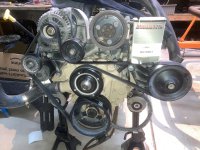Mad Max
Imagineer
- Joined
- May 19, 2020
- Member Number
- 325
- Messages
- 291
Well...after building and wheeling multiple Dodge trucks I'm finally gonna build me a Jeep  .
.
Just picked up this 2014 JKU - it's bone stock, right-hand drive, and other than a hurt engine 100% complete.
The plan. Gonna gut the Jeep's entire driveline and wiring harness, drop in all of the driveline from another rig, and install a fresh yet primitive electrical system with old-school toggles and switches, Speedway column, Grant wheel - not an OE computer in sight. Magnum 360 with Sniper EFI, 46rh trans, Atlas 4-speed, D60 front, 14b rear. Both axles are getting Artec trusses and full-hydro steering. A 4.5" long arm kit from Iron Rock Off Road will smooth out the bumps, and a host of HD armor will protect the body. It'll be fully highway friendly, and a beast off-road, with lots of strategic armor to protect pretty much everyone and everything. Hoping to start jammin' on it Jan 24.
brought this home Thanksgiving Eve 23. I'll keep the majority of the interior, but otherwise I'm gonna pretty much rip everything out of this -

...drop in all of the awesome 5.9 Magnum/46RH/Atlas4/Tons/40s driveline from this -

...incorporate lots of the charm and dirt-simple simplicity of this -

...engineer it to feel and perform pretty much like this -

...and after brushing on Air Force Strata Blue oil-based paint it'll look more or less like this -

...and in the end we'll have 'his n hers' JKUs in the family -
-

Again, I'm going to completely remove the OE Jeep driveline and electrical harness and install a stand-alone, computer-less, dirt simple, primitive, and effective 'switch-to-component' harness, mod the firewall and wiper system for left-hand drive, drop a nice aftermarket 4.5" suspension kit under it, weld on the Artec hardware to utilize the D60/14b, go full-hydro, and rock the hell on. It'll be about 10 times stronger than our M-38...so we're gonna call it the M-380 .
.
- Sam
 .
.Just picked up this 2014 JKU - it's bone stock, right-hand drive, and other than a hurt engine 100% complete.
The plan. Gonna gut the Jeep's entire driveline and wiring harness, drop in all of the driveline from another rig, and install a fresh yet primitive electrical system with old-school toggles and switches, Speedway column, Grant wheel - not an OE computer in sight. Magnum 360 with Sniper EFI, 46rh trans, Atlas 4-speed, D60 front, 14b rear. Both axles are getting Artec trusses and full-hydro steering. A 4.5" long arm kit from Iron Rock Off Road will smooth out the bumps, and a host of HD armor will protect the body. It'll be fully highway friendly, and a beast off-road, with lots of strategic armor to protect pretty much everyone and everything. Hoping to start jammin' on it Jan 24.
brought this home Thanksgiving Eve 23. I'll keep the majority of the interior, but otherwise I'm gonna pretty much rip everything out of this -
...drop in all of the awesome 5.9 Magnum/46RH/Atlas4/Tons/40s driveline from this -
...incorporate lots of the charm and dirt-simple simplicity of this -
...engineer it to feel and perform pretty much like this -
...and after brushing on Air Force Strata Blue oil-based paint it'll look more or less like this -
...and in the end we'll have 'his n hers' JKUs in the family
 -
-Again, I'm going to completely remove the OE Jeep driveline and electrical harness and install a stand-alone, computer-less, dirt simple, primitive, and effective 'switch-to-component' harness, mod the firewall and wiper system for left-hand drive, drop a nice aftermarket 4.5" suspension kit under it, weld on the Artec hardware to utilize the D60/14b, go full-hydro, and rock the hell on. It'll be about 10 times stronger than our M-38...so we're gonna call it the M-380
 .
.- Sam
Last edited:

